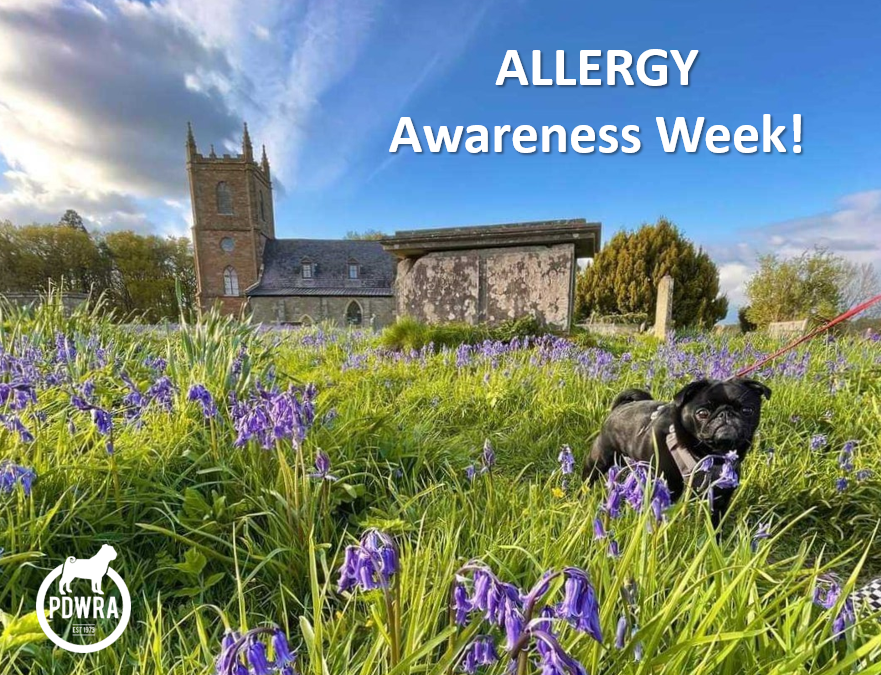
by Yasmin | 24 Apr, 2024 | Blog, News, Pug Health
It’s Allergy Awareness Week, and we want to shed light on a common struggle for our pugs – Atopic Dermatitis.
This condition causes intense itching due to allergic reactions to substances like pollen and household dust. Understanding its signs and treatments can make a huge difference! Keep an eye out for:
– excessive scratching and head-shaking,
– red, sore or flaky skin, around the eyes, ears, in between the paws and on their tummies,
– irritated ears
– rubbing their ears or muzzle
These could all be signs of Atopic Dermatitis.
Left untreated, it can lead to more severe symptoms like hair loss and ear infections. Before jumping to conclusions, it’s essential to rule out parasites like fleas or mites. Once confirmed, treatment involves managing secondary infections and providing relief from itching. Medicated shampoos and ear treatments play a crucial role in this process.
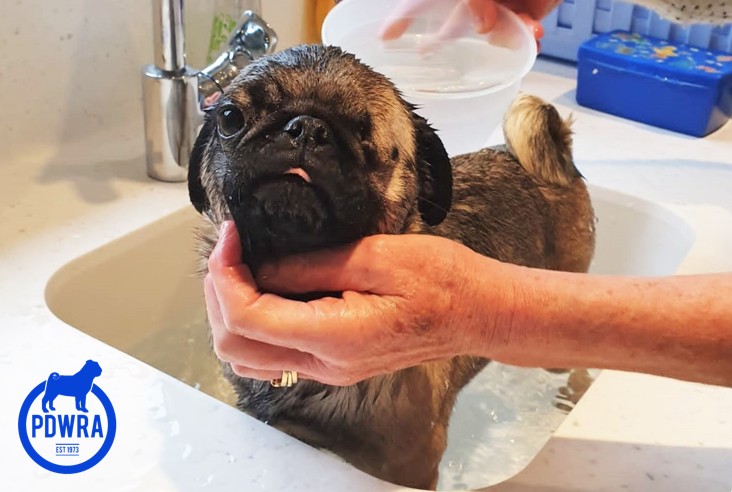
Food allergies can also contribute to Atopic Dermatitis. Exclusive hypoallergenic diets can help pinpoint food-related triggers. Though pricey, it’s an investment in your pup’s health.

Medications prescribed by your vet may offer relief with fewer side effects to traditional steroids, but if symptoms persist you may need a referral to a specialist.
This summary only touches the surface of Atopic Dermatitis, but we hope it provides insight into this common canine condition.
For more details, please read the full article by PDWRA’s volunteer vet advisor, Helen, at: https://pugwelfare-rescue.org.uk/atopic-dermatitis-itchy-skin/
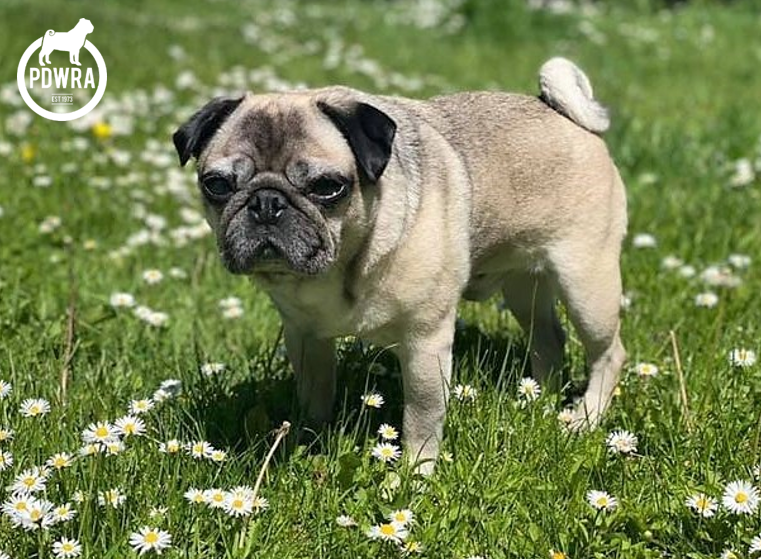
******
For other Pug Health information, please see:
https://pugwelfare-rescue.org.uk/seasonal-hazards-for-pugs/
&
https://pugwelfare-rescue.org.uk/pug-health/

by Yasmin | 11 Aug, 2024 | Blog, News, Pug Health
Article by Helen McKee (MRCVS), PDWRA Vet Advisor:
Pugs can be prone to both these conditions (which are linked), and especially if they are overweight.
Interdigital cysts (also known as follicular cysts or furuncles) are inflamed bumps or nodules located between the toes (interdigital area). These painful cysts can rupture and leak clear or blood-tinged fluid. If the cyst becomes infected, it will leak cream-coloured fluid.
Many factors contribute to the development of interdigital cysts, making them frustrating to manage.
How do interdigital cysts develop?
Interdigital cysts develop as a reaction to inflamed hair follicles between the toes. The inflamed hair follicles rupture into the surrounding tissue, creating more inflammation and swollen “cysts” that can open (ulcerate) and drain. This process is irritating and itchy, causing the dog to lick or chew at the area, which further traumatises the hair follicles, continues the cycle of inflammation, and potentially introduces infection. If not treated quickly, cellulitis and scarring may occur.
What causes interdigital cysts?
Allergy-induced paw inflammation is the most common cause of interdigital cysts. Allergic dogs often have itchiness and recurrent skin infections in other areas, such as their ears. Allergy triggers can include pollen, mites, fleas, and dietary proteins.
Other factors that increase the risk of your dog developing interdigital cysts (especially between the outside two toes) are mechanical in origin. An abnormal amount of friction in the interdigital space can cause inflammation of the hair follicles. This is more likely to occur for obese dogs who put excessive pressure on their paws or pugs that have abnormal leg conformation which alters the weight distribution on their pads as discussed below (under False Pads).
What are the signs of interdigital cysts?
If your dog has interdigital cysts, you will see raised red bumps between your dog’s toes and your dog may be licking or chewing at their feet more than usual. Your dog’s paws may also be discoloured – especially if they have a secondary infection. You may even notice small blood spots on the floor if a cyst has ruptured. Dogs who are in pain may limp or be reluctant to walk.
How is the underlying cause of interdigital cysts diagnosed?
After a complete history and physical examination of your dog, your vet may recommend testing the skin for Demodex mites, bacteria, and yeast by performing skin scrapings, hair plucks, and/or tape preps of the area.
How are interdigital cysts treated?
Treatment is aimed at controlling the underlying cause, so it typically includes allergy treatments, and anti-inflammatory medications such as steroids (prednisolone) and cyclosporine (Atopica™). Other allergy medications, including (Apoquel™) (Cytopoint™), can help control your dog’s itching but aren’t considered to be effective enough to treat the degree of inflammation involved in interdigital cysts.
Secondary infections may require long courses of antibiotics, sometimes up to 8 weeks. Topical treatments like steroid ointments and antimicrobial paw soaks (chlorhexidine also known as Hibiclens) can be very useful to manage superficial inflammation and infection.
If arthritic changes and/or obesity have promoted cyst formation, these chronic conditions need to be managed more effectively with medications and nutritional therapy. Providing protective boots and controlling the surfaces your dog walks on (soft surfaces best like grass) can help manage the disease as well.
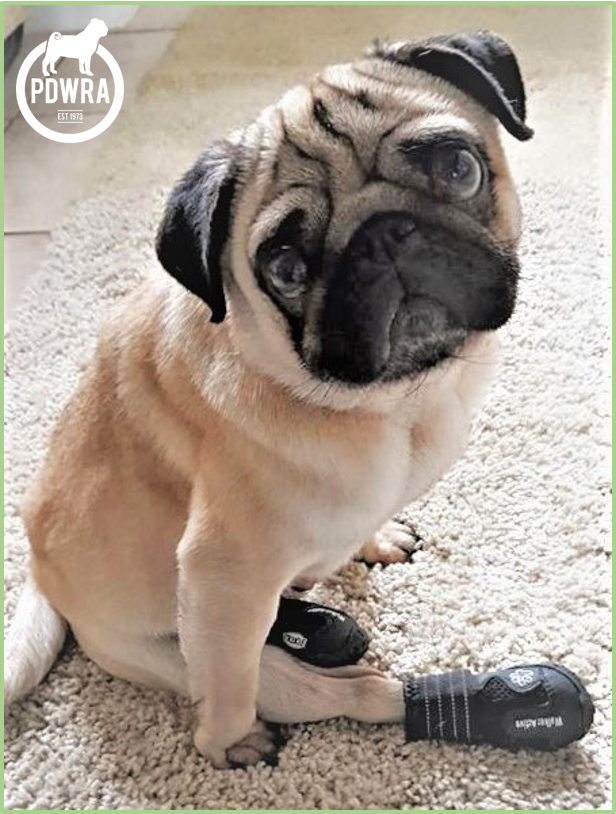
Many cases respond well if an underlying disease is found and treated appropriately. If an underlying disease is not (or cannot be) managed well, interdigital cysts can recur more frequently, causing chronic inflammation, scarring, and pain.
False pads can also result in ‘interdigital cysts’ and can be seen in dogs where abnormal conformation (shape of dog’s legs) results in altered weight bearing on hairy interdigital skin of the paw. Over time, and this can be years, because of the resulting chronic inflammatory changes, the foot tries to form new footpads at the sites; many dogs develop interdigital ‘cysts’ above these areas in the webbing of the pads.
It tends to form on the forelimbs more due to the greater weight bearing load. Because it is conformational, it can be very difficult to manage.
Strategies include weight loss, avoidance of rough terrain (most are better on grass for example), use of little boots out on walks, use of anti-inflammatories (steroids and Atopica can both help in some cases) and in the worst cases, surgery.
Surgery is a very last route to go, and only to be considered in extreme cases of false pads as it involves fusion of toes.
Photos of a case of false pads in a PDWRA rescue pug whom Malcolm and I fostered.
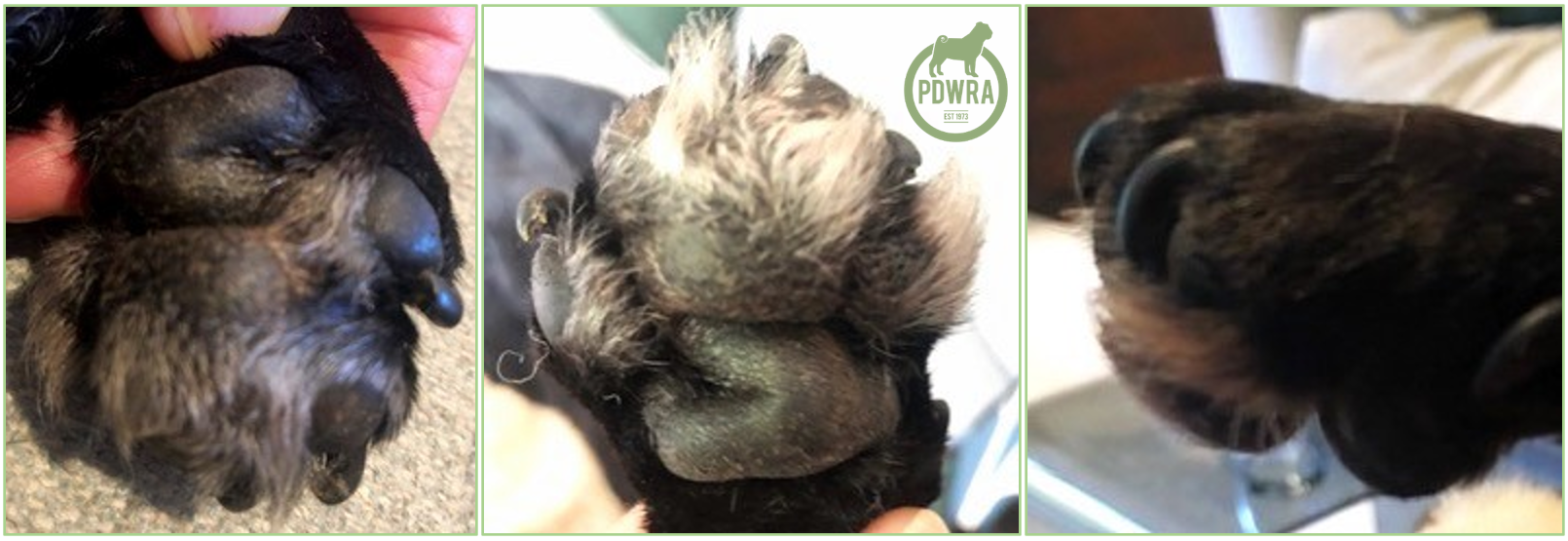
Bella was grossly overweight.
Helen McKee (MRCVS)
PDWRA Vet Advisor
For more useful articles about our pug’s health & wellbeing, please see: https://pugwelfare-rescue.org.uk/pug-health/

by Yasmin | 2 Apr, 2024 | Blog, News, Pug Health
Written by Helen McKee (MRCVS), PDWRA Vet Advisor:
Atopic Dermatitis (Itchy skin)
Atopy is a condition where the body has an allergic reaction to certain substances (like pollen and household dust), and in dogs, it’s expressed as itchiness of the skin (atopic dermatitis). The immune system reacts inappropriately when the dog comes into contact with allergens to which it is allergic and this leads to the skin becoming itchy. Once the dog starts to damage the skin by scratching and rubbing, secondary bacterial and yeast (Malassezia) infections commonly develop.
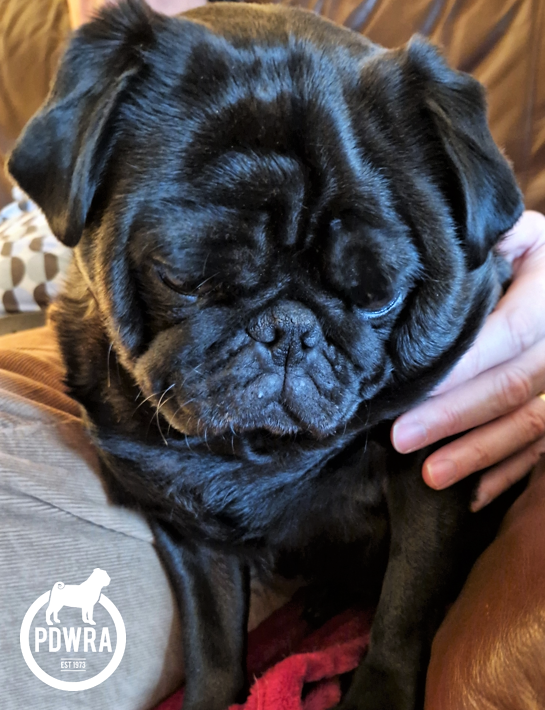
These dogs have a genetic predisposition to develop allergies and unfortunately, it is a condition we see all too commonly in pugs. It is generally caused by inhaling allergens, but less commonly, can also be due proteins in the diet (food allergy).
The main sign is the dog scratching excessively; they can also rub along on their bottom which can be mistaken for anal gland problems. The skin can be red, flaky or with little bumps on it.
Ears are likely to be irritated and inflamed. Because of a pug’s narrowed ear canals, and their enclosed (and moist) nature, it can often result in ear infections.
If left untreated, a dog can become more itchy (pruritic) and develop secondary signs, such as hair loss, thickening (lichenification) and/or blackened skin. Ear canals can be become inflamed, swollen and thickened causing further narrowing of the ear canal.
The first step is to ensure that the itchiness is not being caused by parasites, such as fleas or mites. Ongoing effective flea treatment is important; many of the flea treatment products on the market now also work against mites (such as Bravecto).
Depending on the severity of the condition, a vet may do a skin scraping to to look for mites and secondary infections such as fungo. Once parasites are ruled out, any excessive growth of bacteria and/or fungi need to be treated. Often this is by the use of a medicated shampoo such as Malaseb.

It is also important to treat any associated ear infections. Again, the vet make take a swab of the ear, and look under the microscope. If they see bacteria, especially rod shaped ones (which can be a nasty bacteria) they may go on to culture. Treatment can involve both local treatment (drops into ears), which can be as long as 6-8 weeks in serious cases, and tablets, depending on severity.
Once under control, it is vitally important that ears are part of the ongoing management of the atopy, as ear canals can become so thickened that they block the ear canal resulting in deafness. If this occurs, an expensive operation to remove the ear canal (TECA) may be needed to prevent infection spreading into the middle and inner ear (head tilt, dizziness) or in the most extreme cases, reaching the brain.
Once a diagnosis of atopic dermatitis is made, it can then be treated. The condition does not go away, but generally can be controlled with ongoing management.
If a dog is under 12 months of age, then it is more likely to be food related. If it develops after one year of age, then more often that not, it is due to breathing in allergens like pollen.
The easiest way to rule in (or out) an allergy to certain foods, is to exclusively feed hypoallergenic food for a minimum of 6 weeks. Although these specialised foods are expensive, in my opinion, it is worth the cost to find out if food is a factor in the dog’s atopic dermatitis. There are only three commercially available hypoallergenic diets (where the protein is hydrolysed in the food so the body doesn’t react to the protein), and these are produced by Purina, Royal Canin and Hill’s.

If the condition improves on the diet (without concurrent medication) it gives a positive diagnosis and the dog will need to remain on the diet.
Some vets may suggest blood tests to ascertain the proteins a dog is allergic to, but unless considering immunotherapy, dermatologists can often feel they are not needed and can incur unnecessary extra costs too.
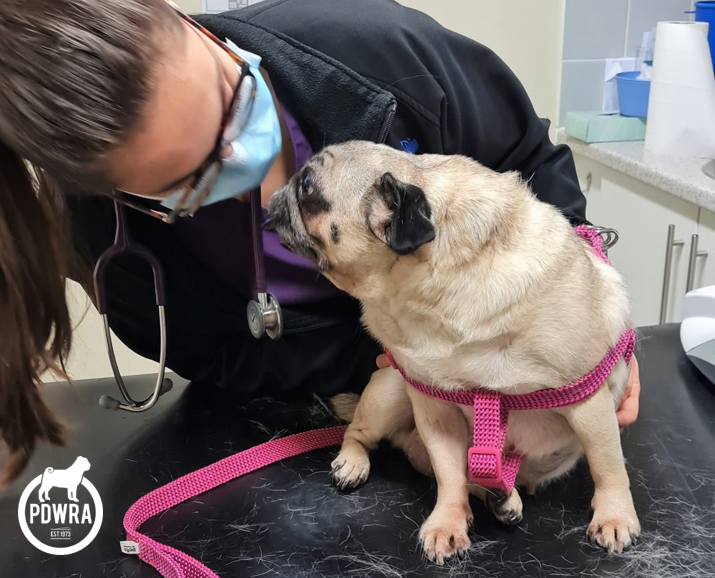
There are a number of drugs that can be used to treat atopic dermatitis. Traditionally, steroids were used but they can have bad side effects.
More modern drugs (with less side effects) include Cytopoint, a monthly injection, and Apoquel, a tablet.
Regular medicated shampoo baths, along with the use of ear flushing products are often used alongside the medication, to control the atopy.
If the symptoms persist despite the use of Cytopoint or Apoquel, I would recommend being referred to an Advanced Practitioner or Specialist in Dermatology to ensure the diagnosis is correct and optimal treatment is given.
This is by no means an exhaustive article, merely a summary of atopic dermatitis which I hope will give a better understanding of the condition.
Helen McKee (MRCVS)
PDWRA Vet Advisor
For further pug health related articles please see: Pug Health & Wellbeing | The Pug Dog Welfare & Rescue Association (pugwelfare-rescue.org.uk)
Pug Health & Wellbeing
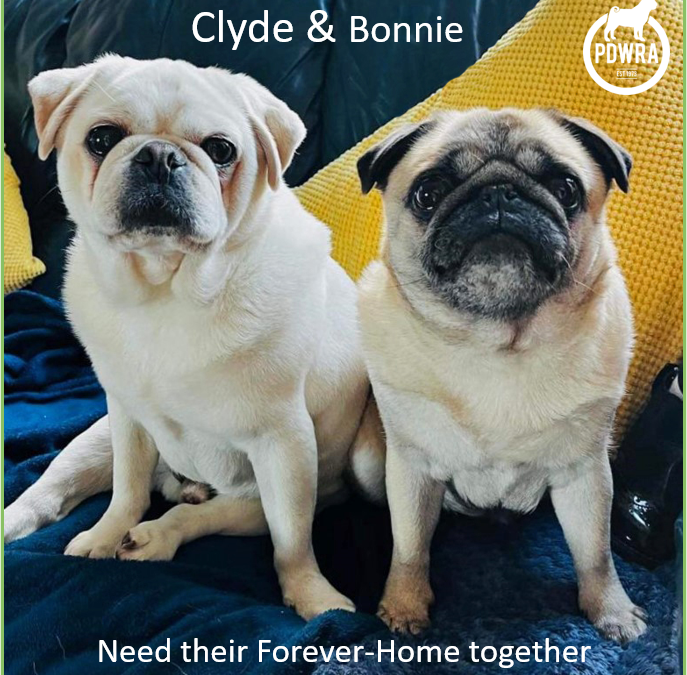
by Yasmin | 19 Feb, 2024 | Blog, News, Rescue Stories
** GREAT NEWS – UPDATE! **
Our Dynamic Duo were snapped up & are living the dream in their new home!
ORIGINAL POST:
Clyde and Bonnie are a strongly bonded, loving pair, 5 & 6 years-old.
They are being rehomed only due to an unfortunate allergy their young human had towards them, in their previous family.
Bonnie is in charge and leads the way for Clyde. He cries if he doesn’t know where she is so they need to stay together. Bonnie is quite fiesty and can dominate other dogs, including a very chilled out pug in foster so we are looking for a home without other dogs as it may be unfair to those already in the home.
Despite this, they are as adorable as they look!
They absolutely love cuddles and nothing more than to snuggle up on the sofa with a human friend. They are great with older and younger children both of which they have lived with before.
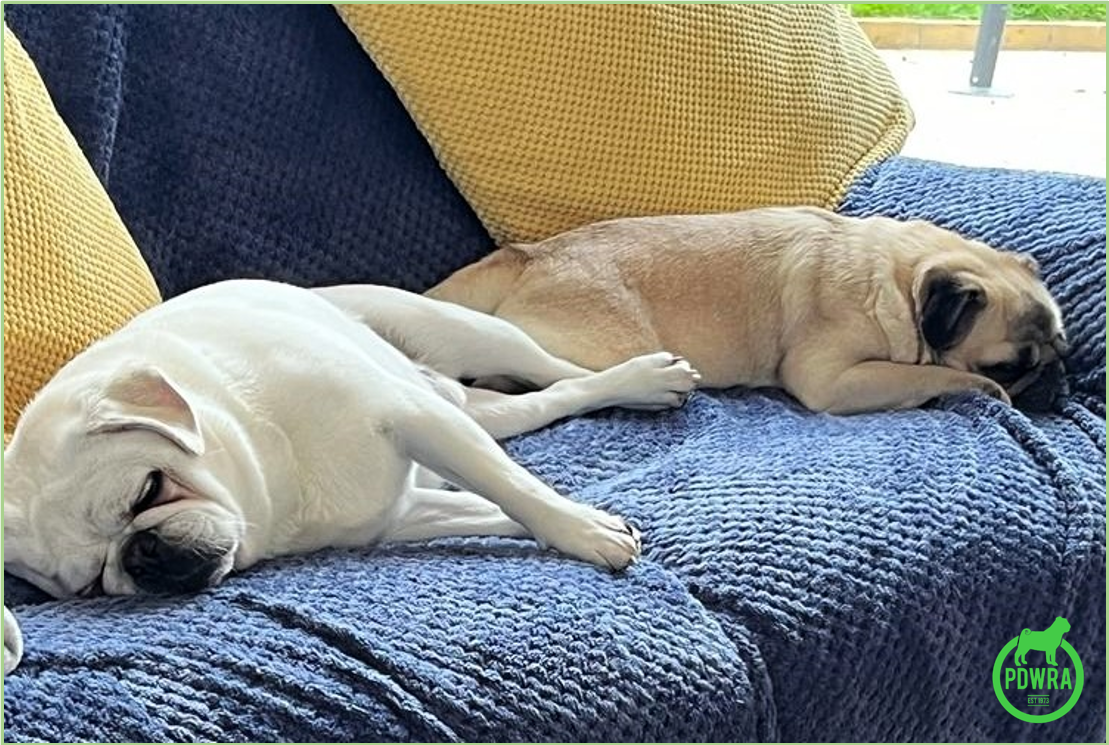
They love their walks. Clyde is great at putting his harness while Bonnie gets over excited and will run round in circles until sorted. They walk well on the lead and Bonnie especially is good when allowed to run off. Clyde will walk further than her if he’s allowed to. Taking him out on his own sometimes gets him more exercise as Bonnie can hold him back.
They are good with other dogs outside of the home but haven’t been tested with cats.
Meal times are peaceful, they eat together, from their own bowls without disturbing the others.
They are both well toilet-trained, Bonnie preferring to go in the garden rather than on her walks. Neither of them have ever had ‘accidents’ in the house.
They are perfect at night time and settle really well. They have a crate which they have liked in the past but prefer their cuddle bed which they sleep on together – their crate is left open at night so they can choose.

So, could YOU or someone you know, offer Bonnie & Clyde their forever home together?
Please apply, quoting Reference: Bonnie 23237 & Clyde 23236 at: https://pugwelfare-rescue.org.uk/adopting-a-pug/
If you are already registered with us to adopt, please speak to your PDWRA Area Coordinator directly.
Thank You, from Bonnie & Clyde!
For other Rescue Stories of ours, please see: https://pugwelfare-rescue.org.uk/category/rescue-stories/
by Janet | 21 Oct, 2018

You want a pug, maybe a bonded-pair? a puppy? You’ve wanted one for years. You hopefully have done some research and believe this is the breed for you.
Please read on if you are not familiar with the breed. There are some things about pugs that aren’t in all the books to see if a pug is the best fit for you.
Let’s start by saying that no two pugs are alike. Don’t assume that because your neighbour’s pug is a slug, yours will be!
It’s a HUGE mistake to judge all pugs by your experience with one or two. They can vary quite a bit in energy, intelligence and temperament, ranging from go-with-the-flow to I’m-in-charge-of-everything.
Gross Generalizations that tend to be true:
- Blacks tend to be busier and have more attitude than fawns.
- Females tend to be pushier and more in your face than males.
- Males tend to be more laid back and easy going than females.
- There are exceptions to all of the above.
Pug Puppies: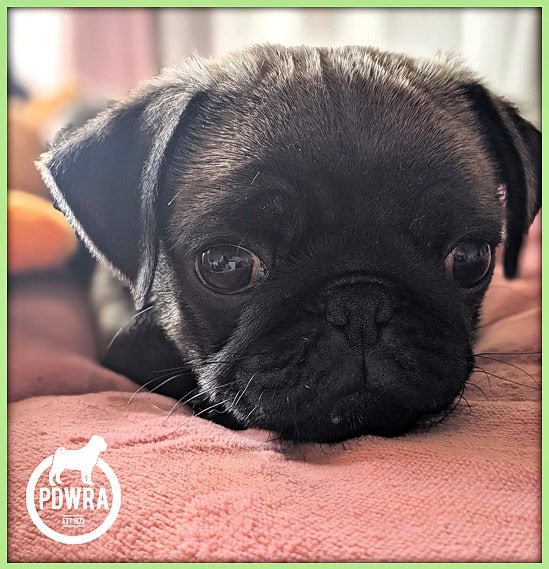
No doubt, you’ve read about how pugs are sweet, affectionate, cuddly and low energy. So you will be rightfully horrified when you find that your puppy is a whirling dervish of energy who snuggles for 30 seconds and then is off again to race around the house, leaving destruction in his or her path. Pug puppies are no different from any other puppy. Expect nipping, chewing, gnawing, jumping, pulling on your trouser legs, shoe destroying, and general mayhem.
Here’s the reality. NO puppy is a couch potato. They are all lunatics. Some more than others. You likely won’t have a couch potato pug until at least the age of two and your pug may NEVER be a couch potato. Pugs from reputable breeders are more likely to have the pug temperament eventually, but even they will be devils as a puppy. If your puppy is from the internet, a pet store, a newspaper ad, then it’s up for grabs what kind of temperament you may end up with. You might get a pug that has the solid and stable temperament that is the signature of the breed, but you might also end up with a high drive, high energy pug that won’t settle down for several years, if ever.
One of the best ways to wear a puppy out (or any busy dog) is to engage them in activities that make them work and think. This is why obedience classes are so great – it may only be an hour, but that’s a hard hour of learning and really takes the ‘edge’ off of a busy dog.
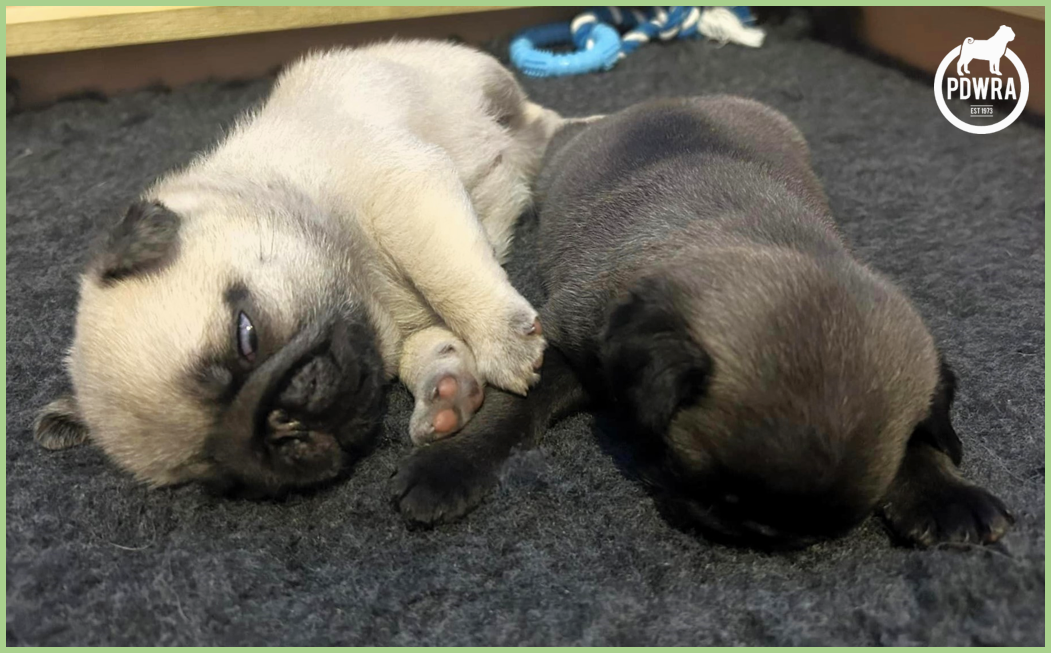
Pugs are and were bred to be companion animals. They need people. If you are going to be gone for long periods of time and/or be too tired to engage with your pug when you get home from work, then a pug probably isn’t the dog for you. And pug puppies will need you to engage with them. They will demand it (as will most adults). Just like children, puppy brains need stimulation and activity to develop.
A puppy left crated for eight to ten hours will be absolutely manic by the time you get home and will need you to devote the remainder of the evening to them. They are often referred to as a Velcro dog, so if you don’t want a dog that is going to be wherever you are all the time (including in the bathroom!), then rethink getting a pug.
Please also read: Thinking of Getting a Pug Puppy? | The Pug Dog Welfare & Rescue Association (pugwelfare-rescue.org.uk)
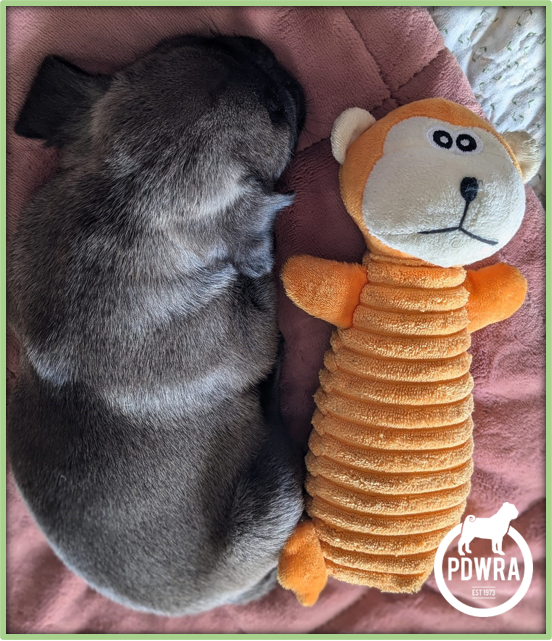
House Training:
Pugs will not be house trained in a month or two months or even six months. Some pick it up quickly, but most take a year or longer and may still not be 100% reliable. And most pugs won’t ask to go out. You might be able to train them to ask, but in my experience, most pugs don’t learn this or if they do learn it, they figure it equals a treat (assuming you give a treat to your dog after going outside). You may end up with a pug that asks for food as opposed to letting you know they want to go out.
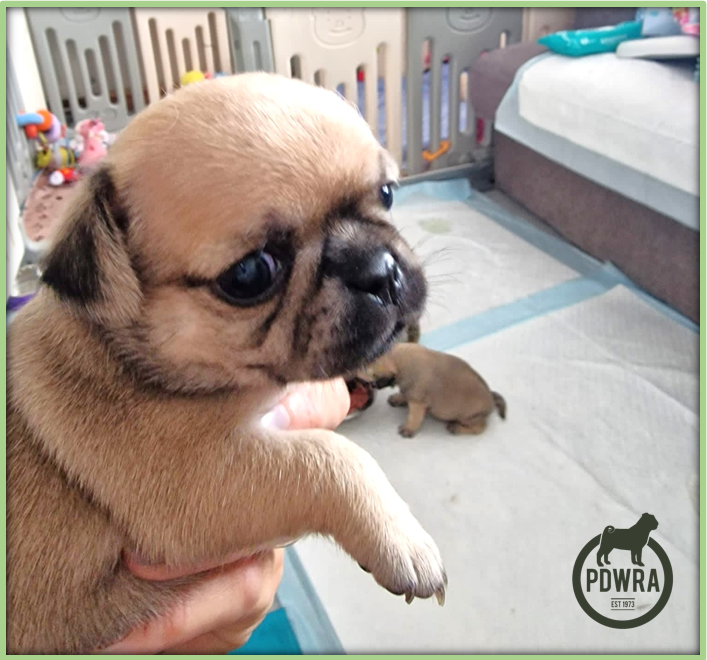
Pugs generally will not just go outside and do their business while you sit nice and warm in the kitchen and have a coffee. If they are outside, you’d better be outside, too. Most will not excrete outside without your company and encouragement. Many will also fake it, pretending to pee, but these quirks are part of the charm of the breed.
While some pugs can last all day while you’re at work, most can’t and none should be expected to. When was the last time you had to hold your bowels or bladder for eight to ten hours at a stretch? So if you are contemplating a pug (or small breed dog) then be sure that you can afford to have someone come in and let the dog out or make arrangements for the dog to excrete in an ‘approved’ spot.
Punishing a pug for an accident is not an effective method of house training. Praise for appropriate toileting will win the day – eventually – but scolding, yelling, hitting, or rubbing the dog’s nose in the mess will not house train the dog and will likely create a dog that will become a sneaky excreter. There are many good books and articles on house training.
Be prepared that if you have a pug puppy, you may well have to get up at night – two, three or four times a night – until they are six months or older.
Pug Quirks: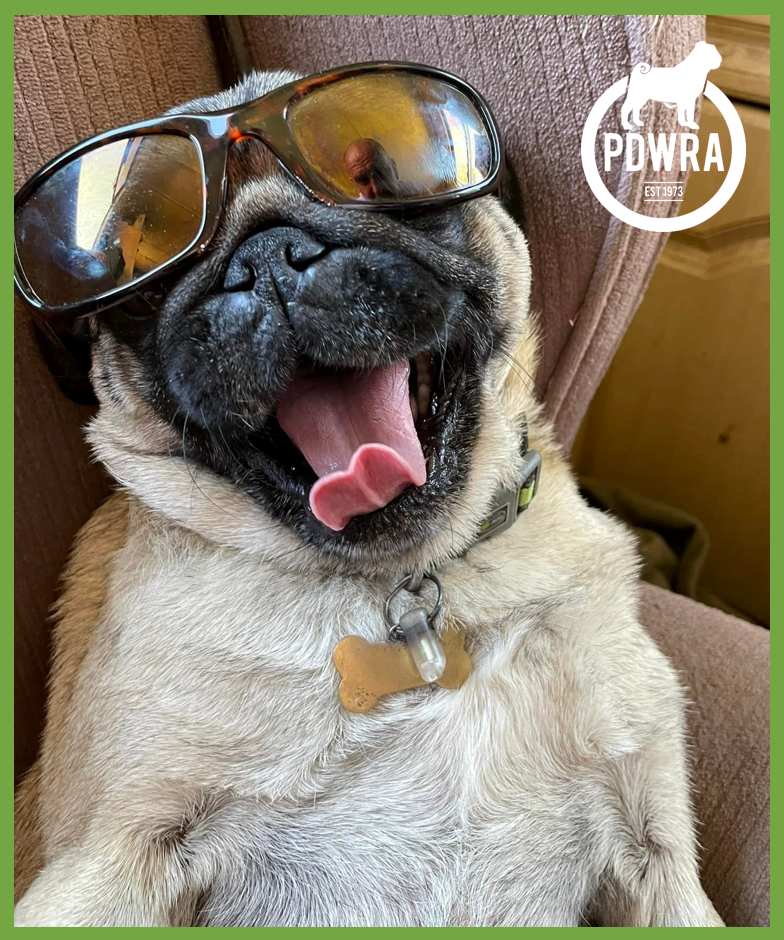
Pugs have a variety of quirks that drive some people nuts. They are nosey, inquisitive, and often right under foot. Many are tremendously food driven and will consume things that you don’t consider edible. I’m not kidding. They will eat sticks, rocks, coins, screws, plastic caps off of bottles. You name it, they will eat it. They figure out quickly that the command “drop it” means you’re going to take it away so many will swallow the forbidden object rather than give it up. It is your job to pug proof your home to avoid tragedy.
Many have tissue and toilet paper addictions that they have all their lives. I have known several to think eating used tissue is a true delight and will go out of their way to access it. I never trust any pug around any food source, rubbish bin or even cabinets that they can open.
Quite a few will “table surf”. If they can get onto your dining room or kitchen table, they will. And they will consume whatever is up there.
Pugs are often quite tactile. Many are obsessive lickers – of themselves, you, the other dogs or cats, the kids, the carpet, your pillow. It’s a pug thing. Many use their paws more like hands than paws. Quite a few are “swatters” and will use their paws to whack you or other animals – generally to play or get attention.
Pugs can be quite vocal and can be barkers, howlers, moaners and grumblers. I have known of many that were vocal in the extreme and would carry on protracted conversations with their owners. As a breed, they have the widest assortment of noises I’ve ever heard. And some snore very, very loudly.
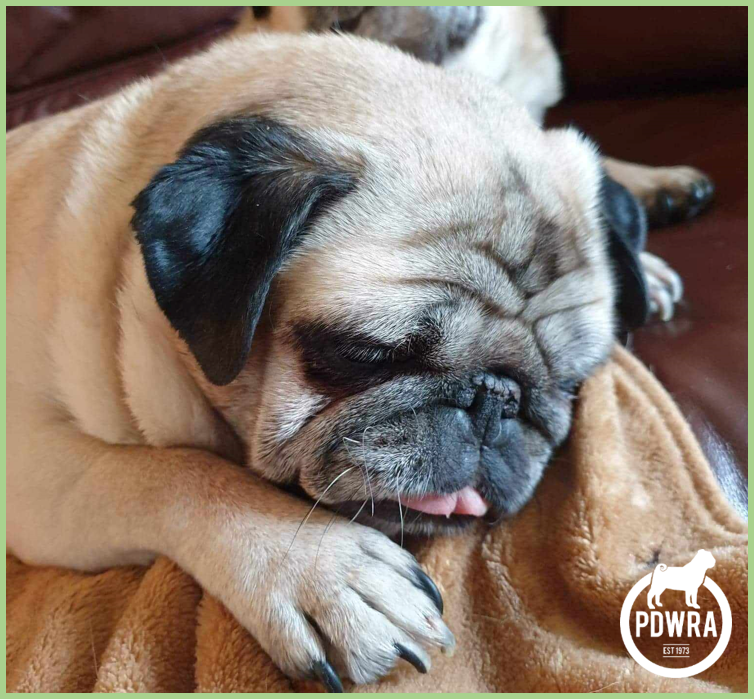
Pugs are tough little dogs that have no clue how small they are. Most will not initiate a fight, but many will vigorously defend themselves or others if a fight starts. Most are hopelessly outclassed in the fighting department and will get seriously hurt.
As a deeply food driven breed, you may have issues with food aggression and resource guarding. Make sure that you do research on working with these issues.
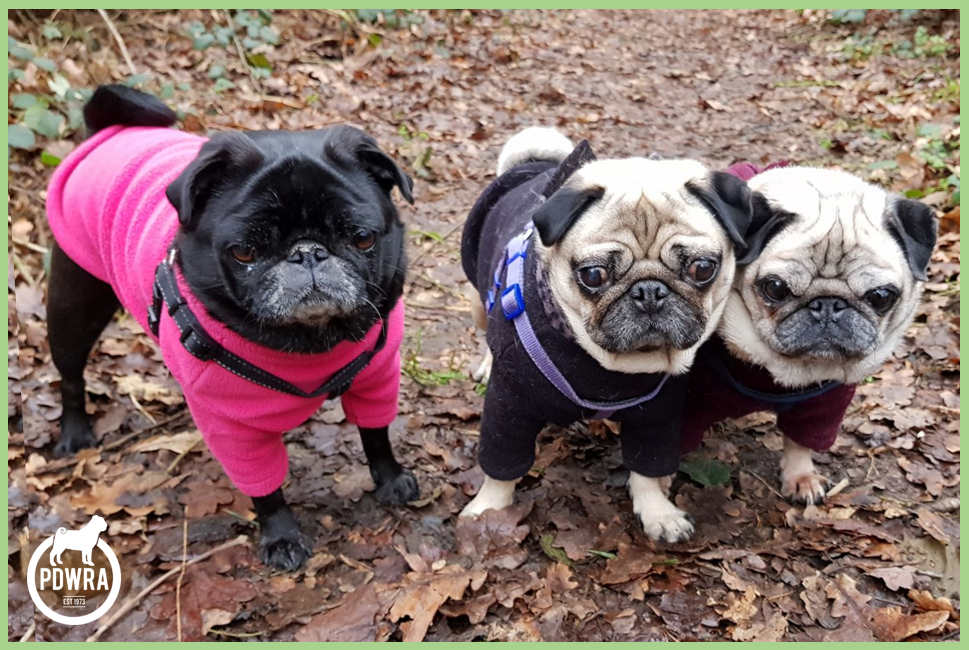
Many pugs are not fans of inclement weather and will resist toileting outside in the cold, rain or wind. Some are fine, but in my experience, many will refuse (or try to refuse) to toilet outdoors. Some will simply use your floors, some will hold their bowels and bladder for frighteningly long periods of time too. This is not healthy for them.
Few pugs will show any remorse or other indication that they know they did wrong by having accidents in the house. Some will, but most will happily mark floors and look at you like “What? I went to the door and you weren’t there so I used the floor. Get over it”.
No dog can be trained to be “traffic smart”. And don’t fool yourself that you can do this or that your neighbourhood is safe. Pugs (any dog, in my opinion) should not be off lead in any environment where they can get away from you and end up on the road or lost. They can be remarkably fast and it only takes a second for a dog to be hit by a car.
They have a remarkable capacity for bodily excretions. Expect to get your face sprayed at regularly, eye gunge will appear on clean clothes and occasionally the foul smell of anal gland excretions can appear anywhere they’re able to plant their bottoms. they can scoot on the ground when their glands are blocked or need emptying and they are uncomfortable. Some owners may need to regularly visit the vet to help with this.
Pugs are Smart:
Pugs are often tagged as dumb dogs. Most aren’t. In fact, most are smart enough and stubborn enough to figure out how to get their way or how to outlast you. Positive training, setting rules and boundaries are crucial with this breed if you don’t want to end up with a thug. Since they are often very food driven, treats are very effective in training pugs.
And they are dogs. Let’s remember that. They aren’t little people, much as we like to think of them that way. They need to do dog things – go to parks, meet other dogs, play and have fun. Just as you wouldn’t raise a human child in isolation with no rules, it isn’t good for a pug to be raised in isolation where there are no rules or boundaries. Pugs are very adept at figuring out what you will and will not tolerate and will test the limits. You don’t need to be a dictator, but all dogs like to know what the routine is and like a predictable world.
Pug Energy:
While they aren’t sporting dogs, all pugs need exercise. Yes, quite a few would prefer to laze on the sofa all day, but that isn’t good for them. There are pugs that excel at agility, and at obedience. They don’t have to be slugs and most importantly, they shouldn’t get FAT. This can be a real struggle as they always act like they haven’t eaten in a week, have pitiful, soulful eyes and for some reason some of them just seem to think of food and put on weight. It really is important to remember that they need the right amount of food for the activity level of the dog. You don’t do your dog any kindness by letting them get obese; you will shorten their life significantly.
Please also read: FIT not FAT! | The Pug Dog Welfare & Rescue Association (pugwelfare-rescue.org.uk)
As mentioned earlier, they can be wildly busy puppies and many first time pug owners get very discouraged. They may slow down with time and age, but you need to be sure that your pug, regardless of energy level, gets exercise and mental stimulation.
Pug Health:
This, more than any other issue, is often the undoing of a pug owner. Like all pure bred dogs, pugs have some health issues that may crop up and they are often expensive health issues. DO YOUR RESEARCH on the breed and especially on where you are getting your pug.
Rescues generally have a good idea of the health issues facing a given dog – don’t assume that a rescued pug is going to be a health nightmare, many are simply being rehomed due to their owners’ circumstances.
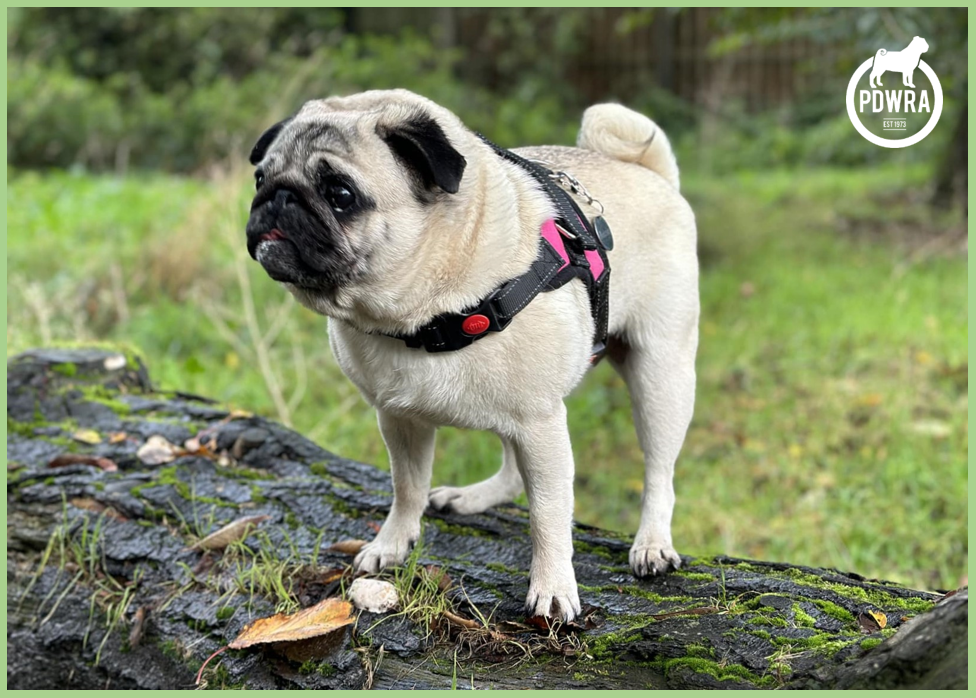
You do put yourself at risk for expensive health issues with pugs from pet shops, internet ads and the newspaper. Most reputable breeders will have genetic testing going back generations. It’s no guarantee that your pug won’t have an issue, but it does decrease the odds.
Pugs are prone to issues specific to brachycephalic (flat faced) breeds (breathing, eyes, folds of skin) and are prone to issues of the toy breeds generally (luxating patella, dental problems, trachea). And then there is Pug Dog Encephalitis (PDE) that is pug specific.
Please see: Protein Losing Enteropathy (PLE). | The Pug Dog Welfare & Rescue Association (pugwelfare-rescue.org.uk)
Pugs have a very high rate of allergies – food being a big one – grains in particular. Pugs need a high quality diet. Shop brought kibble may not cut it and you can avoid a host of future problems if you start off feeding your pug a good diet, whether raw or a premium kibble.
Atopy is where an allergic reaction to inhaled substances (allergens, such as pollen and household dust), expressed in dogs as itchiness of the skin (atopic dermatitis). These dogs have a genetic predisposition to develop allergies and unfortunately, is another condition common to pugs.
It can also be due proteins in the diet (food allergy).
For further information on this, please see: Atopic Dermatitis (Itchy skin!). | The Pug Dog Welfare & Rescue Association (pugwelfare-rescue.org.uk)

Pugs have a high rate of vaccine reactions. Be watchful and conservative in your vaccination protocol.
Pet Insurance.
Think seriously about insurance for your pug. It can be a life saver, literally. If you don’t or won’t get insurance, then have a plan for what you will do when the first £2,500 vet bill crops up. It can happen. An eye injury in a pug can go from simple scratch to serious ulcer in 24 hours and need a corneal graft that will run you into some serious cash. Be prepared for this so that you aren’t sitting at the vet’s trying to figure out what to do because you can’t afford the vet care needed.
Please see: PDWRA’s vet advice on Pet Insurance | The Pug Dog Welfare & Rescue Association (pugwelfare-rescue.org.uk)

They Are A High Maintenance Breed!
Don’t get me wrong. I love pugs, but they are, to my mind, a high maintenance breed. They need and want a lot of attention. They moult like maniacs. I’m not kidding about the moult. It’s downright astonishing.
They can be bossy, stubborn, and full of naughtiness. They require a fair bit of watching and managing in terms of safety, health and general training. They can and will get themselves into trouble – by dashing into the road (if off the lead) to get a piece of squashed sandwich, chewing on your power cords, opening up your cupboards (which you thought were safe) and 7.5 kg bag of kibble, and jumping off of a height and snapping a leg bone.
They tend to need some pretty regular grooming, cleaning of nose folds, eye areas and are notoriously fussy about having their nails trimmed. You can see some real dramatic behaviour around nail clipping in particular. I’ve known several pugs to start screaming as if they were being killed before the nail trimming even started …..
They do a thing called Reverse Sneezing. Read up about it and save yourself a trip to the emergency vet. All pugs do it.
This is one of the most affectionate and overtly loving breeds I’ve ever owned. To me, they are worth the effort, expense and time that they require. They are clowns and comics and will provide hours of laughter and entertainment. But as a pug owner, you MUST be aware of the care involved in this breed.
We are grateful to one of our supporters for sending us this article for publication.
You will find a range of recent, useful pug health articles at: Pug Health & Wellbeing | The Pug Dog Welfare & Rescue Association (pugwelfare-rescue.org.uk)


























